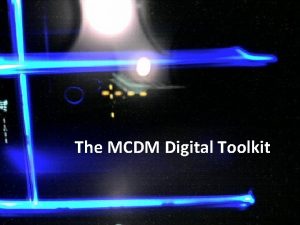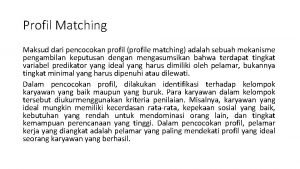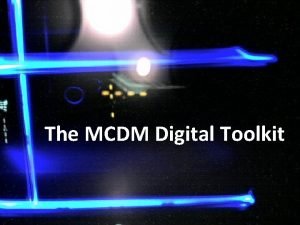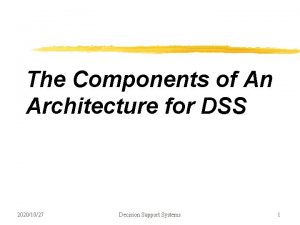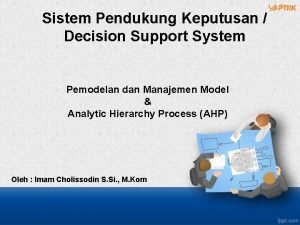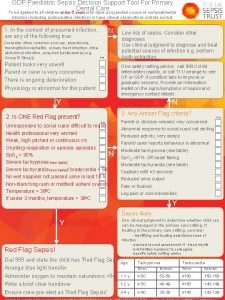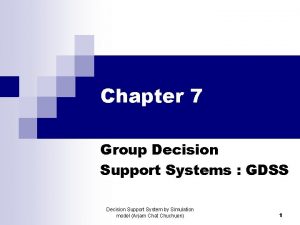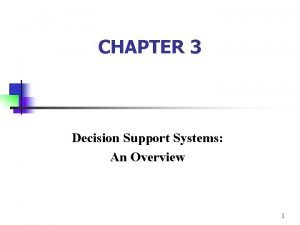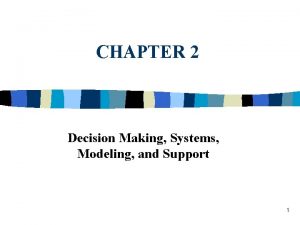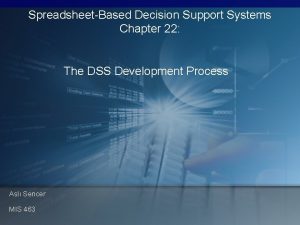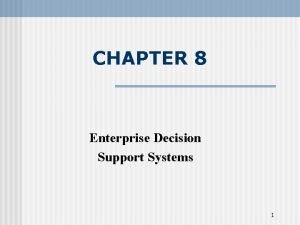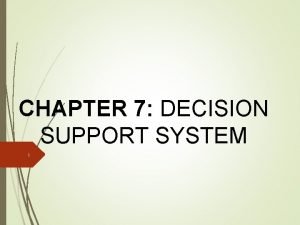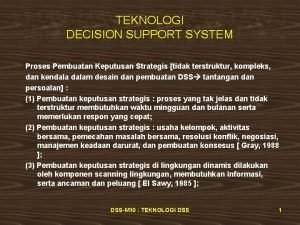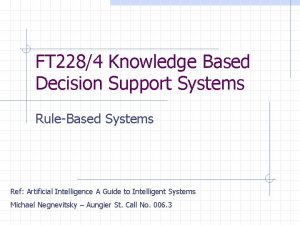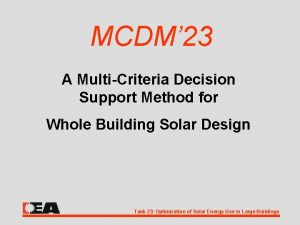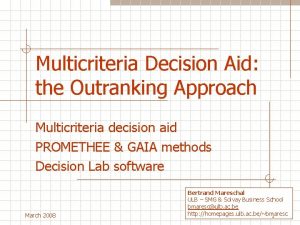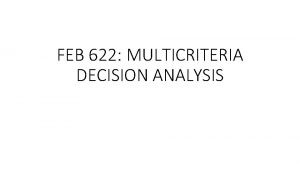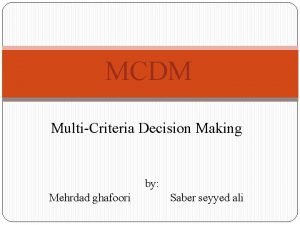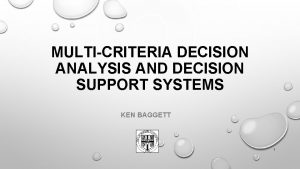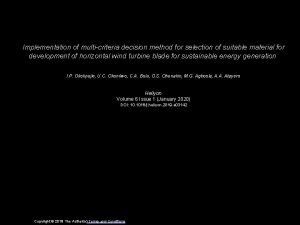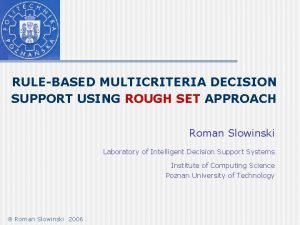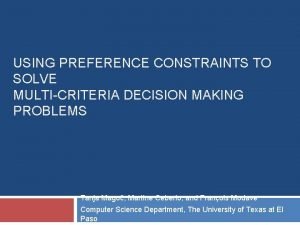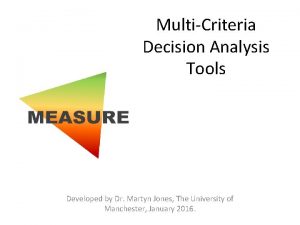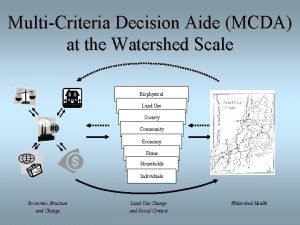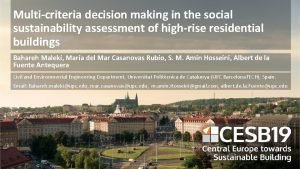MCDM 23 A MultiCriteria Decision Support Method for






























- Slides: 30

MCDM’ 23 A Multi-Criteria Decision Support Method for Whole Building Solar Design Task 23: Optimization of Solar Energy Use in Large Buildings

MCDM-23 was developed within International Energy Agency Solar Heating and Cooling Task 23 “Optimization of Solar Energy Use in Large Buildings” Task 23: Optimization of Solar Energy Use in Large Buildings

Requirements for Successful Solar Building Design: n Start with a client and design team committed to high performance, and willing to alter the normal design process n Select a design team with a wide range of technical skills n Add an energy engineer and other relevant specialists to the team n Commence with teamwork from the very start of the Pre-design Stage n Define performance goals at the outset and referring to them throughout n Use new methods and tools throughout the process Task 23: Optimization of Solar Energy Use in Large Buildings

MCDM’ 23 seeks to facilitate some of the challenges of integrated design: · Application and integration of knowledge and judgements from a range of experts from different disciplines · “Balanced” specification and integration of design criteria that are incommensurate and may be conflicting (e. g. economics vs. environment, aesthetics, etc. ) · “Balanced” integration of both quantitative and qualitative performance criteria (qualitative criteria tend to be undervalued or poorly documented) Task 23: Optimization of Solar Energy Use in Large Buildings

Problems in doing tradeoffs: · Criteria have different units (k. Wh, $, kg of SO 2, percent satisfied, score on a scale of ten, etc. ) · Some are quantitative, some are qualitative · For some, smaller is better (resource use), for others, bigger is better (quality issues) How to picture diverse criteria together so we can decide between alternatives? Task 23: Optimization of Solar Energy Use in Large Buildings

MCDM-23 is a structured approach to: · Make judgements and values explicit to promote learning and cooperation across disciplines and to reach a common understanding of the overall design problem · Handle values and judgements alongside quantitative assessments in order to clearly see the overall goodness of the design · Help organize and select relevant information and to focus on the most important issues Task 23: Optimization of Solar Energy Use in Large Buildings

WHO should use MCDM’ 23? · In the building design process: All members of the design team, including the client · In a design competition: The competition organizers and the judging committee · A person needs to be appointed to organize the work with the method and to take care of the mechanics of aggregating the information Task 23: Optimization of Solar Energy Use in Large Buildings

WHEN should MCDM’ 23 be used? · For selecting and specifying design criteria in the pre-design phase, and for prioritizing among design criteria · For evaluating alternative design strategies and solutions at various stages in the design process Task 23: Optimization of Solar Energy Use in Large Buildings

WHAT is MCDM’ 23? A method and tool based on CRITERIA, WEIGHTS AND SCORES that is a means to encourage the members of the design team to make their knowledge, values and judgements EXPLICIT - so that the other members (and the outside world) can better understand, learn and interact! Task 23: Optimization of Solar Energy Use in Large Buildings

STEPS in MCDM’ 23 Step 1: Select and describe main criteria and sub-criteria Step 2: Develop measurement scales for sub-criteria Step 3: Weight the main criteria and sub-criteria Generate alternative solutions Step 4: Predict performance Step 5: Aggregate scores Step 6: Analyze results and make decisions Task 23: Optimization of Solar Energy Use in Large Buildings

STEP 1 DESCRIBE, SELECT, AND STRUCTURE CRITERIA · Top-down approach: Start with overall objectives, then go into details · Bottom-up approach: Test the criteria on relevant alternatives (cases) · Start out wide (use check lists), then narrow in · Document the reason why a criterion is important: · Irreversible consequences? · Wide ranging consequences? · Far from fulfilling national goals? Task 23: Optimization of Solar Energy Use in Large Buildings

STEP 1 DESCRIBE, SELECT, AND STRUCTURE CRITERIA Advantages of a hierarchical structure: main goal (optimal housing area) Main criteria (e. g: resource use, functionality, comfort) • Lower-level criteria explain the concrete meaning of upper-level criteria Sub-criteria (e. g. energy use) • Helps sorting out redundancies and double counting Indicators (e. g. k. Wh/m 2) • Allows keeping the overview as well as going into the details Task 23: Optimization of Solar Energy Use in Large Buildings

Example of criteria set for main criterion Resource Use Sub-criteria Sub-sub-criteria Indicators Energy Net use of energy MJ/m²/person Land Net area of land used m²/occupant Change in ecological value judgement Water Net consumption of water m³/year/person Materials Retention of existing building % of floor area Use of recycled materials % of cost Re-useable materials % of cost Re-cyclable materials % of cost Task 23: Optimization of Solar Energy Use in Large Buildings

STEP 2 DEVELOP MEASUREMENT SCALES FOR SUB-CRITERIA Score 10 Judgement excellent 9 8 good 7 6 fair 5 4 marginally acceptable Task 23: Optimization of Solar Energy Use in Large Buildings

Example of measurement scale for quantitative criteria Annual Electric Use Task 23: Optimization of Solar Energy Use in Large Buildings

Example of measurement scale for qualitative criteria Score 10 9 Judgement excellent 8 good 7 6 fair 5 4 marginally acceptable Adaptability Different clients without change Different clients by moving adjustable partitions Different clients by rebuilding nonload bearing partitions Different clients by rebuilding some non-load bearing partitions Different clients by rebuilding mostly non-load bearing partitions Different clients by rebuilding all load bearing partitions Not adaptable to different clients Task 23: Optimization of Solar Energy Use in Large Buildings

The value of creating scales · Generates a concrete discussion about how the building should perform · The process of setting end-points leads to an active search for alternative options: “Can we not do better than that? ” · Facilitates interpretation of criteria: the same words may have different meanings for different individuals · Helps define the general nature and context of the problem - may lead to restructuring of the model · Allows each member of the team to express his or her own expertise to the group as a whole Task 23: Optimization of Solar Energy Use in Large Buildings

STEP 3 WEIGHT THE MAIN CRITERIA AND SUB-CRITERIA Grade Relative importance (compared with the most i mportant criteria) 10 9 8 7 6 5 4 Of equal importance Somewhat less important Significantly less important Much less important Task 23: Optimization of Solar Energy Use in Large Buildings

Example of weighing using the tool Pie chart button displays graphic Task 23: Optimization of Solar Energy Use in Large Buildings

The value of weighting · Make values and hidden judgements explicit to the group as a whole · Generates discussion and visualizes different viewpoints · May lead to a redefinition of the scales · Helps focusing on the most important issues Task 23: Optimization of Solar Energy Use in Large Buildings

GENERATE ALTERNATIVE SOLUTIONS ………… Task 23: Optimization of Solar Energy Use in Large Buildings

STEP 4 PREDICT PERFORMANCE using · computer simulations · databases · rules of thumb · experience · expert judgement Task 23: Optimization of Solar Energy Use in Large Buildings

Enter the number in the program Click the button to plot the value on the value graph Task 23: Optimization of Solar Energy Use in Large Buildings

STEP 5 AGGREGATE SCORES Task 23: Optimization of Solar Energy Use in Large Buildings

STEP 6 ANALYZE RESULTS AND MAKE DECISIONS After entering all the values for all the schemes, there are four results options: 1) Worksheet for each scheme 2) Star diagram for each scheme 3) Summary bar graph showing all schemes 4) Summary table showing all schemes Tables can be exported as comma-delimited files. Diagrams can be copied to the clipboard. Both can be printed. Task 23: Optimization of Solar Energy Use in Large Buildings

Worksheet Provides documentation of the process Scheme B is not so good ( 5. 6 out of 10 ) Task 23: Optimization of Solar Energy Use in Large Buildings

Star Charts Functionality Task 23: Optimization of Solar Energy Use in Large Buildings

Bar Graphs Function ality Task 23: Optimization of Solar Energy Use in Large Buildings

Summary Table This table was generated automatically in MCDM-23, copied directly from the screen, and pasted into this presentation. It can also be exported as a csv file. Scheme A is the best ( 8. 98 out of 10 ) Task 23: Optimization of Solar Energy Use in Large Buildings

CONCLUSION MCDM’ 23 is a means to organize the multi-criteria design work and to understand learn about what’s important NOT to produce the “right answer”! Task 23: Optimization of Solar Energy Use in Large Buildings
 Mcdm uw
Mcdm uw Metode mcdm
Metode mcdm Uw mcdm
Uw mcdm Objectives of decision making
Objectives of decision making Investment decision financing decision dividend decision
Investment decision financing decision dividend decision Decision table and decision tree examples
Decision table and decision tree examples Types of tps system
Types of tps system Dss architecture components
Dss architecture components Contoh spk motor honda
Contoh spk motor honda Navify decision support
Navify decision support Decision support systems and intelligent systems
Decision support systems and intelligent systems Gdp sepsis decision support tool
Gdp sepsis decision support tool Components of decision support system
Components of decision support system Gdss
Gdss Mdm support technologies in dss
Mdm support technologies in dss Data management subsystem in dss
Data management subsystem in dss Components of decision support system
Components of decision support system Types of decision support system
Types of decision support system Decision support system vs expert system
Decision support system vs expert system Decision support and business intelligence systems
Decision support and business intelligence systems Developing spreadsheet-based decision support systems
Developing spreadsheet-based decision support systems Model driven decision support system
Model driven decision support system Decision support system in knowledge management
Decision support system in knowledge management Iliad clinical decision support system
Iliad clinical decision support system Excutive support system
Excutive support system Objectives of dss
Objectives of dss Decision support system dashboards
Decision support system dashboards Introduction to decision support system
Introduction to decision support system Proses decision support system
Proses decision support system Knowledge based decision support system
Knowledge based decision support system Benefits of decision support system
Benefits of decision support system
